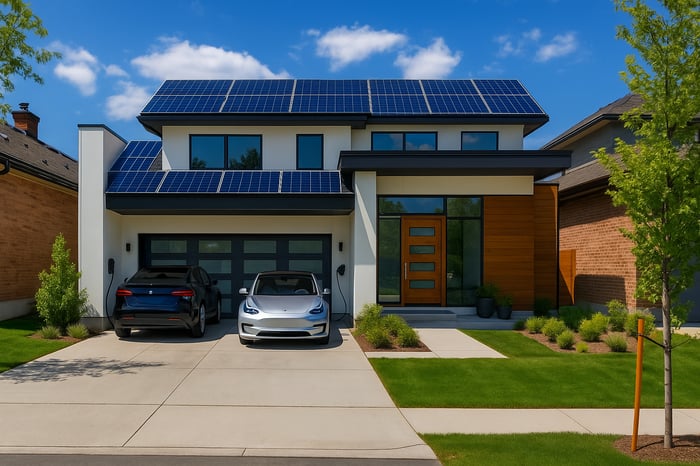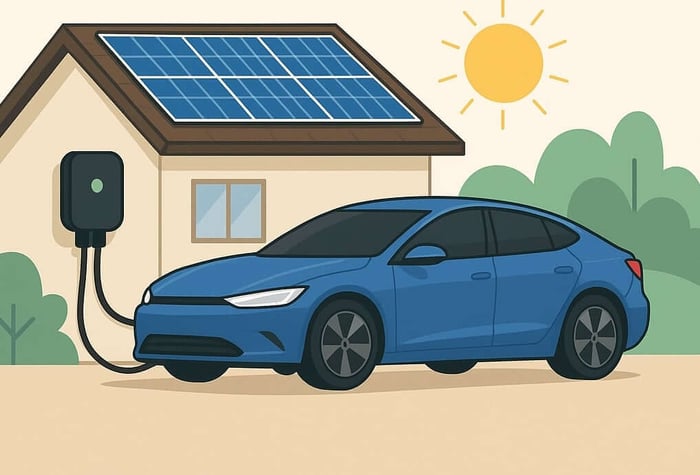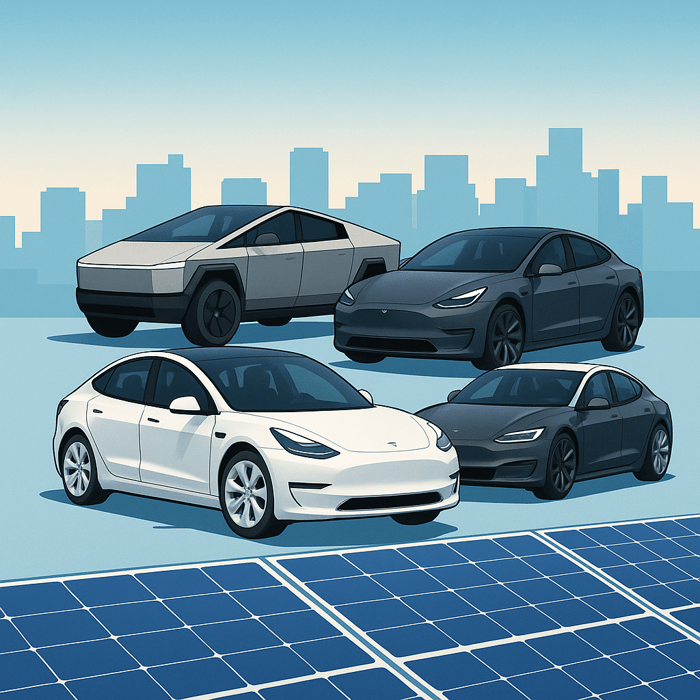By Holden Koiiker, COO at NeoCharge | Updated July 2025
Quick Answer: PG&E net metering 2025 has changed dramatically since NEM 3.0 launched in April 2023, reducing solar export credits by ~75%. However, EV owners can still save thousands annually by optimizing when they charge. Smart EV charging systems can increase your solar savings by up to 60% compared to random charging patterns.
What Every PG&E Customer with an EV Needs to Know Right Now
If you're a PG&E customer with solar panels and an electric vehicle, you're sitting on a goldmine of potential savings – but only if you know how to unlock them.
"The biggest mistake I see EV owners make is treating their car like a giant energy vampire that randomly drains power," says Holden Koiiker, COO of NeoCharge, a leading smart EV charging company. "With PG&E's new time-of-use rates and NEM 3.0, timing is everything. The difference between smart and random charging can be $2,000+ per year."
Here's everything you need to know to maximize your savings in 2025.
How PG&E Net Metering Actually Works (The Simple Version)
The Basic Deal: PG&E pays you for extra solar power you send back to the grid, but the rates and rules have changed dramatically.
The Three Eras of PG&E Net Metering
| Period | Export Credit Rate | Key Changes |
|---|---|---|
| NEM 1.0 (Pre-2016) | Full retail rate | Simple 1:1 credit system |
| NEM 2.0 (2016-2023) | Retail rate minus small fees | Added time-of-use requirements |
| NEM 3.0 (April 2023+) | ~25% of retail rate | Massive reduction in export value |
Bottom Line: If you have solar panels, you want to use that power yourself rather than selling it back to PG&E. And the best way to do that? Charge your EV when the sun is shining.
Why NEM 3.0 Changes Everything for EV Owners
Under the old system, it didn't matter much when you used your solar power. A kilowatt-hour was worth roughly the same whether you used it directly or sold it back to PG&E.
Now? It's completely different.
The New Reality:
- Using solar power directly: Save $0.30-0.50 per kWh
- Selling to PG&E then buying back: Net value ~$0.08-0.12 per kWh
Real Example: A Model 3 uses about 300 kWh per month. Smart charging during solar production saves $60-120 monthly vs. random charging patterns.
PG&E Time-of-Use Rates: Your EV Charging Playbook
PG&E's "electrification" E-ELEC rates are designed specifically for customers with EVs and solar. Here's when electricity costs what:
Peak Hours (Most Expensive): 4 PM - 9 PM Weekdays
- Rate: $0.50-0.65+ per kWh
- Strategy: Never charge during these hours unless absolutely necessary
Off-Peak Hours (Cheapest): 12 AM - 3 AM Daily
- Rate: $0.25-0.35 per kWh
- Strategy: Perfect for overnight charging when solar isn't available
Partial-Peak Hours: 3 PM - 4 PM & 9 PM - 12 AM Weekdays
- Rate: $0.35-0.45 per kWh
- Strategy: Charge during off-peak hours when solar is going.
For the most current rate details, check PG&E's official EV rate plan information.
The Smart EV Charging Strategy That Saves $2,000+ Annually
Koiiker has analyzed thousands of PG&E customers and identified the optimal charging pattern, especially for EV drivers charging with NEM 3.0:
Phase 1: Solar-First Charging (8 AM - 3 PM)
"When your panels are producing power, that's free fuel for your car," explains Koiiker. "Our data shows customers who charge during peak solar hours save 60% more than those who charge randomly. Plus you get to charge with 100% clean energy that you generated."
Phase 2: Off-Peak Backup (12 AM - 8 AM)
For longer trips or cloudy days, overnight charging at off-peak rates provides the backup you need.
Phase 3: Peak Avoidance (4 PM - 9 PM)
"These five hours can destroy your monthly savings," warns Koiiker. "We've seen customers add $200+ to their monthly bill by charging during peak hours."
How PG&E's 50% Rebate Makes Smart Charging Affordable
Here's something most people don't know: PG&E offers up to 50% off smart EV charging equipment like the NeoCharge Smart Splitter equipment (100% for income-qualified customers).
What Qualifies:
- Certain smart EV charging stations
- Load management devices like the Smart Splitter
How to Apply:
- Purchase qualifying equipment
- Submit rebate application with receipt
- Receive credit on next PG&E bill
Pro Tip: This rebate can reduce the cost of a smart charging system from $800 to $400, paying for itself in 3-4 months through optimization savings.
The Hidden Costs Most PG&E Solar Customers Miss
1. Non-Bypassable Charges (NBCs)
Even with solar, you still pay ~$0.03-0.05 per kWh for grid maintenance and environmental programs.
2. Monthly Grid Connection Fee
$10-15 monthly just to stay connected to PG&E's grid.
3. Demand Charges (For Some Rate Plans)
Peak usage charges that can add $50-100 monthly if you're not careful.
The Fix: Smart energy management systems help you avoid these hidden costs by optimizing when and how you use power.
Should You Still Install Solar with NEM 3.0?
Short Answer: Yes, but the math has changed.
Before NEM 3.0:
- Solar payback period: 6-8 years
- Focus: Maximize system size
After NEM 3.0:
- Solar payback period: 8-12 years
- Focus: Maximize self-consumption
For EV Owners: The payback is still attractive because you have a large, controllable load (your car) that can soak up excess solar production, and use apps like the NeoCharge App to sync your EV charging with your solar inverter for automatic savings.
Considering solar installation? Compare current solar installer options in PG&E territory to find the best rates and installers in your area.
What About Battery Storage?
"Batteries are becoming the game-changer for PG&E customers," notes Koiiker. "Store your solar power during the day, then use it to charge your EV during peak hours. It's like having your own personal gas station."
The Economics:
- Cost: $15,000-25,000 for home battery system
- Savings: $150-200 monthly in peak hour avoidance
- Payback: 8-15 years with federal tax credits
5 Mistakes PG&E EV Owners Make (And How to Avoid Them)
1. Charging During Peak Hours
Mistake: Plugging in when you get home (4-9 PM) and charging right away
Fix: Wait until 11 PM or charge during the day with solar
2. Oversizing Solar Without Load Management
Mistake: Installing huge solar system without way to use the power
Fix: Add smart EV charging and or home battery energy storage to maximize self-consumption
3. Ignoring Time-of-Use Optimization
Mistake: Set-and-forget charging schedules
Fix: Dynamic charging that responds to your solar production and TOU rates
4. Not Taking Advantage of PG&E Rebates
Mistake: Paying full price for smart charging equipment
Fix: Apply for PG&E's 50% rebate program and get Level 2 charging installed with the Smart Splitter.
5. Focusing Only on Solar Export Credits
Mistake: Trying to maximize how much power you sell back
Fix: Focus on self-consumption and peak hour avoidance
Your Next Steps: How to Start Saving This Month
Immediate Actions (This Week):
- Check your PG&E rate plan - Make sure you're on an EV-friendly time-of-use rate
- Track your charging patterns - When are you currently charging?
- Calculate your peak hour usage - How much are those 4-9 PM hours costing you?
Short-Term Upgrades (Next Month):
- Install smart charging capability - Take advantage of PG&E's 50% rebate
- Optimize your charging schedule - Shift to solar and off-peak hours
- Monitor your savings - Track the immediate impact
Long-Term Strategy (Next 6 Months):
- Consider battery storage - For maximum peak hour avoidance
- Right-size your solar system - Focus on self-consumption, not export
- Explore whole-home energy management - Optimize beyond just EV charging
Q: How much can I save with smart EV charging?
A: $2,000+ annually by avoiding peak hours and maximizing solar self-consumption
Q: What’s PG&E’s rebate for smart charging?
A: Up to 50% off equipment costs (100% for income-qualified customers)
Q: When should I charge my EV with solar panels?
A: 8 AM–3 PM when your panels produce the most power
Q: What happens if I charge during peak hours?
A: You’ll pay $0.50–$0.65/kWh vs. $0.25–$0.35/kWh off-peak
The Bottom Line: Smart Charging Pays for Itself
With PG&E's new rate structure, smart EV charging isn't optional – it's essential for maximizing your savings. The good news? The technology exists today to automate all of this optimization.
"I've seen customers reduce their electricity bills by 40-60% just by shifting when they charge their car," says Koiiker. "With PG&E's rebates, the payback period for smart charging equipment is typically 3-4 months. After that, it's pure savings."
Ready to optimize your PG&E EV charging costs? The combination of solar power, smart charging, and PG&E's rebate programs can save you $2,000+ annually and is easy to automate with the NeoCharge App. The key is getting the timing right.
Holden Koiiker is COO of NeoCharge, a leading smart EV charging company that helps homeowners optimize their energy costs. NeoCharge's solutions are eligible for PG&E's rebate programs and have helped tens of thousands of California customers reduce their electricity bills.
Free PG&E Energy Assessment: Want to see how much you are saving on home energy and solar? Get the free NeoCharge app and start understanding today.








